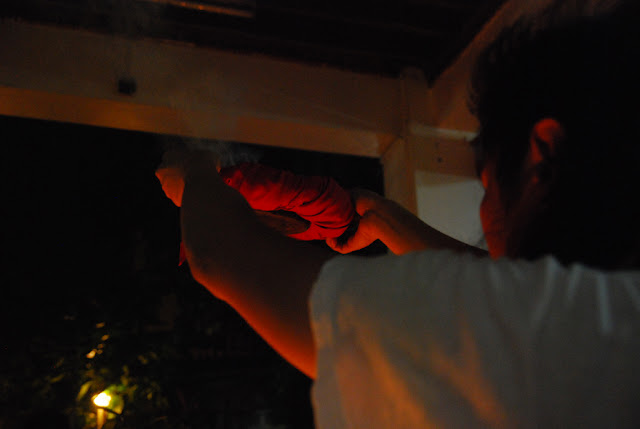1. Gerald Gardner, known as the father of Wicca, never actually used the word "Wicca" nor "Wiccan". He referred to his religion as "witchcraft" or "the Old Religion", and its followers, "the Wica". Ironically it was from his adversary, Charles Cardell, where the word "Wicca" actually came from.
G.B.Gardner and an unfortunate chap.
2.
"Wicca" is an Old English word simply meaning "witch". In the middle ages this word is pronounced as "witcha". Whether it also denotes the meaning of "wise" is still largely debatable in the field of etymology.
3. While a sabbat is a gathering of witches for the purpose of religious celebration of the seasons, an
esbat is a gathering of witches for any other occasion. It does not necessarily have to fall on a full moon, nor does it even have to be religious at all.
"Wiccans" of the "Alexandrian" tradition - words in quotes were not yet 'invented' at the time of this photograph. Here a coven of witches dance around a magic circle lead by self-proclaimed "King of the Witches", Alex Sanders.
4. Gardner was initiated into the
New Forest coven - not the Black Forest coven. The Black Forest tradition would be established many years later by the American witch Silver Ravenwolf.
5. Only four of the
sabbats are based on ancient Celtic festivals: Samhain, Imbolc, Beltane and Lughnasadh. The Celtic names given to the sabbats are a fairly new addition, in the older books they are simply called Halloween, Candlemas, May Eve, and Lammas. Yule and Ostara are based on Germanic celebrations. Mabon and Litha didn't get their names until the 1970's. Gardner's coven originally celebrated only the four 'Celtic' feasts. Celebration of the solstices and equinoxes were added later thanks to the influence of the modern druidic movement.
6. Hecate, a popular patron deity among Wiccans, while known as a
triple-goddess, was never viewed by the ancient Greeks nor modern Hellenic reconstructionists as maiden-mother-and-crone. The same is true with the Celtic triple goddesses Brighid and the Morrighan. The concept of the maiden-mother-crone triplicity is a modern and Wiccan concept and was introduced to the world by the poet Robert Graves in his pseudo-anthropological book "The White Goddess".
7. The
athame is used for casting a circle, calling the quarters, and drawing the pentagram on the air - but not for invoking the God and the Goddess. The
wand, which is a symbol of the spirit and the connection with the higher world, is much better suited for this purpose. Pointing a sharp weapon to someone isn't particularly a respectful gesture. (See photo of Gardner above.)
The magician - raising the wand and connecting with the divine source.
8. "All gods are one god, and all goddesses are one goddess" is the general theistic philosophy of Wicca, popularized by occultist and psychiatrist Dion Fortune. Some Wiccans believe that this is the widespread belief among all Pagan religions. But this is actually closer to the theistic belief of the Hindus (monistic), than that of classical Paganism (polytheistic). While this Jungian concept of gods remains popular today, many other pagans are polytheists (all gods are not one, but separate identities), pantheists (all is god), panentheists (all is in god), non-theists (no gods, just spirits), and even atheists (no gods at all).
A note from a reader: "...The diamond theory, although usually taught in many covens, especially during Outer Court training, is not Wiccan theology. That's propagated by most authors. In actuality, Wicca (that is, the Traditional side aka "original" Wicca) is an orthopraxic system. In other words, practice is more important than belief...they are not taught how to interpret the Gods or even their experiences in the Mysteries; rather, they are told that experiencing those things and practicing in the same, effective manner as the rest of the coven, is enough. It doesn't matter whether they are agnostics, polytheists, monotheists or even atheists..." - Alorer
9. Whether you like it or not,
Aleister Crowley - also known as the Great Beast, Frater Perdurabo, 666 - did play a huge part in the formation of ideas and rituals of what was to be known as Wicca.
10. Gardner spent much years of his life living in India, South-East Asia and Ghana, both to earn a living and to study the indigenous religions of these lands, some of which he may have adapted into Wicca. The concept of 'skyclad', for example, came from the digambara practice of the Jains of India - 'digambara' literally meaning 'sky-clad'. It might be possible that he has studied the beliefs as well of our local tribes, as he wrote in his historic book:
"Pygmies now live in the same way in Central Africa, Malaya, New Guinea, the Deccan, Ceylon and the Philippines. I have known many of them and they all use poisoned arrows, and are thought to possess magical powers" -- Witchcraft Today
________________________________________________________
I have been around with our local Wiccan community for many years now, and at times I've been called to teach or lead a smaller group. I listed above some informational tidbits which I find that many among our local Wiccan-folk might not be aware of. While these may be dismissed as trivial I hope that it would encourage beginning Wiccans to learn more about the facts and history of their faith. Although I am no longer Wiccan it doesn't mean I no longer have to put my energy into learning about it. My path today has actually taken me even closer to its origins and beliefs.
Blessed Be!











































































